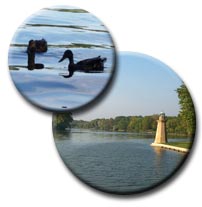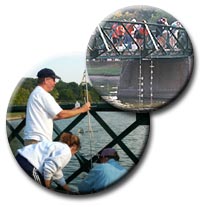Fox River Watershed Investigation - Description
 The headwaters of the Fox River watershed are in Waukesha County,
Wisconsin. The majority of the watershed is in Illinois and includes parts of McHenry, Lake, Kane, Cook, DuPage, DeKalb,
Kendall, and LaSalle Counties with minor drainage from Will and Lee Counties. Within Illinois, the Fox River watershed
has distinctive natural segments. The uplands of the watershed are relatively flat, with marshes and lakes. The Fox River flows
through a series of lakes called the Chain of Lakes and Stratton Dam near McHenry, is operated to maintain minimum lake levels.
As the Fox River flows through Kane County, the watershed narrows. The land becomes hilly with bluffs encroaching on the floodplain,
and the watershed narrows to a minimum width of 10 miles near Geneva. South of Geneva, the watershed widens again and the
land is relatively flat. The Chain of Lakes is a unique area defined at its downstream point by Stratton dam. The proposed
study area includes: the urbanized and relatively flat region with numerous lakes and marshes downstream of Stratton Dam to
Algonquin (McHenry and Lake Counties), the narrow, relatively hilly, urbanized and urbanizing area between Algonquin and Montgomery
(Kane, Cook, and DuPage Counties) and the flatter, broader watershed, that is still predominantly rural between Montgomery and the
mouth at Ottawa (DeKalb, Kendall and LaSalle Counties). The Chain of Lakes presents a complex system that initially will
be treated as an upstream boundary condition. Thus it will be possible to first focus efforts on the on sources and processes
in the study area. Once the dynamics of water quality in the study area is understood, it will be important to address the
impact of upstream activities.
The headwaters of the Fox River watershed are in Waukesha County,
Wisconsin. The majority of the watershed is in Illinois and includes parts of McHenry, Lake, Kane, Cook, DuPage, DeKalb,
Kendall, and LaSalle Counties with minor drainage from Will and Lee Counties. Within Illinois, the Fox River watershed
has distinctive natural segments. The uplands of the watershed are relatively flat, with marshes and lakes. The Fox River flows
through a series of lakes called the Chain of Lakes and Stratton Dam near McHenry, is operated to maintain minimum lake levels.
As the Fox River flows through Kane County, the watershed narrows. The land becomes hilly with bluffs encroaching on the floodplain,
and the watershed narrows to a minimum width of 10 miles near Geneva. South of Geneva, the watershed widens again and the
land is relatively flat. The Chain of Lakes is a unique area defined at its downstream point by Stratton dam. The proposed
study area includes: the urbanized and relatively flat region with numerous lakes and marshes downstream of Stratton Dam to
Algonquin (McHenry and Lake Counties), the narrow, relatively hilly, urbanized and urbanizing area between Algonquin and Montgomery
(Kane, Cook, and DuPage Counties) and the flatter, broader watershed, that is still predominantly rural between Montgomery and the
mouth at Ottawa (DeKalb, Kendall and LaSalle Counties). The Chain of Lakes presents a complex system that initially will
be treated as an upstream boundary condition. Thus it will be possible to first focus efforts on the on sources and processes
in the study area. Once the dynamics of water quality in the study area is understood, it will be important to address the
impact of upstream activities.
The Fox River flows from Wisconsin through northeastern Illinois and joins the Illinois River at Ottawa. The Fox River drains 938 square miles in Wisconsin, and 1720 square miles in Illinois. The river and the land in the watershed are used for many purposes and are under increasing pressure from development as the watershed is a highly desirable place to live. The main stem of the Fox River and the Chain of Lakes region are used for recreation and provide unique aesthetic attractions. The Fox River is used as a source of potable water for public water supply. The Fox River and its tributaries carry storm water and are the receptors of effluents from numerous wastewater treatment plants. In Illinois, the population of Fox River watershed by 2020 is expected to increase by more than 25 percent from the 2000 totals, with much of the growth in McHenry and Kane Counties. Consequences of this population growth will be greater demand on the Fox River for public water supply, storm water and effluent assimilation, and without proper planning, decline of water quality.
Various interest groups within the Fox River watershed have voiced concerns about water quality and other watershed scale issues. There have been numerous studies of the Fox River and its tributaries but findings are fragmentary. A comprehensive investigation of the watershed has not been conducted since 1978, which is over 20 years ago and significant changes have take place since then. The Fox River watershed has been altered both physically and chemically by human activities. The water quality of Fox River and some of its tributaries does not meet all current regulatory goals.

The Illinois State Water Survey has proposed a multi-phase study of the Fox River watershed from Stratton Dam to the Illinois River confluence. Stratton Dam serves as a control point for the Fox Chain of Lakes. Activities in the watershed upstream of Stratton Dam do and will have impacts downstream. A comprehensive study of the Fox River watershed must ultimately consider the watershed as a whole and involve interest groups from the Chain of Lakes region and Wisconsin. The proposed plan of study of the watershed below Stratton Dam is a starting point for looking at the issues specific to this part of the watershed for later incorporation into a full watershed plan.
The Illinois Environmental Protection Agency, at the request of the Fox River Study Group, has funded the first phase of the study that includes an assessment of watershed issues of major concern including water quality, land use, and impacts of population growth, and an in depth review of contemporary water quality studies and data. This information will be compiled to provide a comprehensive and coherent description of watershed issues, the status of water quality in the watershed, and a qualitative understanding of the various mechanisms contributing to the current conditions of the Fox River watershed between Stratton Dam and Ottawa. A database of basic water quality data will be compiled that provides a foundation for future modeling, analysis, and comparative study with complimentary GIS coverages. Appropriate computer models will be identified to model critical parameters.
On the basis of the review and assessment conducted in phase one, the watershed study plan will be developed during the second phase of the project. The plan will include an evaluation of modeling and data needs, and design of a watershed monitoring and modeling plan. Models will be partially calibrated using existing data. This work will provide the basis for future modeling efforts with the ultimate goal of developing a fully calibrated, predictive suite of watershed and river water quality models that can be used for evaluating management practices and aiding with decision making.
The comprehensive watershed study plan will be implemented in phase three of the project. This phase will include data collection, monitoring, extensive model calibration and application. A watershed scale model will be calibrated for the study area. The watershed model will entail various components that incorporate land use, watershed hydrology, and transport mechanisms.
Throughout the project, staff from the ISWS will be meeting with the Fox River Study Group, providing project updates for review and comment.
- Home
- | Data
- | Maps/GIS
- | Models
- | Publications
- | Research
- | Agencies
- | Visualizations
All files and information © 2018 Illinois State Water Survey. Disclaimer.
Email the Web Administrator with questions or comments.

